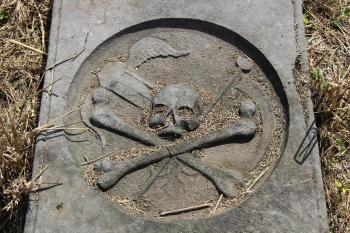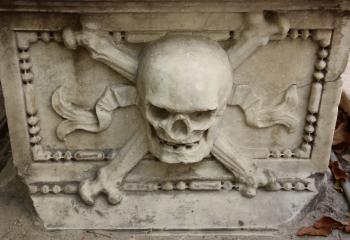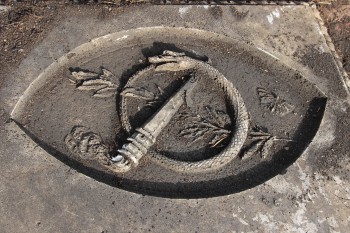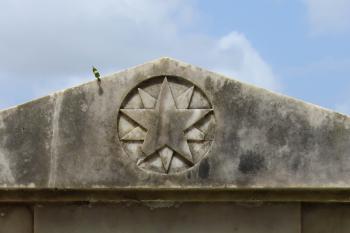Glossaries
| Term | Definition |
|---|---|
| scythe |
The scythe is the attribute of death. In the European Middle Ages, death is already depicted as a skeleton, with a scythe in the right hand. This symbolizes the inexorableness of death. |
| shell | Symbol of fertility, love, marriage and life. Christian symbolism regards the shell as an image of the grave, which encloses man after death, before he is allowed to rise. The representation of the fertilization of the shellfish, considered androgynous, by the dew from heaven, also makes the shell the symbol of Mary. |
| shofar | Jewish symbolism. The shofar or ram's horn blown during Rosh Hashanah (New Year) and Yom Kippur (Day of Atonement). |
| skeleton | The personification of death, often with the scythe and an hourglass. |
| skull |
A skull with bones refers to the ephemeral life and relativity of all earthly possessions. |
| snake |
In art the snake is often a symbol of evil and a biblical synonym of Satan, 'the old serpent'. We also find the snake at the foot of the cross. It is a reference to the serpent from paradise who, according to Christian teachings, had brought man to ruin, a curse that was only lifted by the death of Christ on the cross. Sometimes Adam and Eve were also depicted in addition to the serpent, making the connection even clearer. In the funerary sense we find the positive symbolism of the snake on funerary monuments, but also on gatehouses at cemeteries. A common sight is the tail-biting snake, the ouroboros. The snake here is alpha and omega, the beginning and the end. It points to the limitation, to the fact that everything is contained within the power of God, and to infinity. The healing snake can sometimes be seen in the form of an esculap on the grave monuments of doctors. It is an ancient Greek, and pre-Christian, symbol of medicine. The symbol consists of a staff with a snake wrapped around it. The word esculap refers to the Greek god of medicine, Asklepios. |
| soap bubble |
A soap bubble has been a symbol of transience since the sixteenth century. 'Homo Bulla' (man is a soap bubble) was used as an epitaph. |
| square | The square, the quadrilateral and the cube represent the earth and earthly existence. This is in contrast to the triangle, which represents the heavenly. The number four is related to the universe stretching in the four directions of the sky. Four is the number of the created world of the four elements, but also of the four seasons and the four ages of life. In Revelation (21:16) the New Jerusalem measures as long as it is wide as it is high. Some monuments have a cube or square (diamond) turned with the corners pointing up and down. This illustrates earthly existence and the directions of the earth and heaven. |
| star |
Reference to Christ, to new life and to heaven. A five-pointed star can also represent the five wounds of Christ. A five-pointed star is called a pentagram. Symbol for success and health. In the Middle Ages, a five-pointed star was used to ward off demons. Hexagram, a six-pointed star, is a combination of 3 equal triangles. An example is the Star of David, a Jewish symbol. The triangle with the point pointing upwards would symbolize the masculine and the triangle downwards the feminine. |
| Star of David | The Star of David or Shield of David, Maĝeen David in Hebrew, is a well-known Jewish symbol. When found in a cemetery, the star symbolizes the Jewish faith. The Star of David is a hexagram, that is, a six-pointed star, consisting of two intertwined triangles. However, it is not originally an exclusive Jewish symbol and is also found in Eastern religions and even in Western churches, for example. The symbol hardly appears in early Jewish literature and works of art. The symbol is also not found on old Jewish funerary monuments. Despite the reference to King David, there is no evidence that David's shield was shaped like a Star of David.
|
| sun | The sun plays a major role in many religions in the form of the sun god. In the Christian world of images, the sun rising again and again in the east is a symbol of immortality and the resurrection. On funerary monuments we encounter the sun on the one hand as the halo behind the head of Christ (represented as ruler of time), on the other hand often as a semicircle representing the rising sun and thus referring to the immortality of man and the resurrection. |
| sunflower | The sunflower represents unwavering dedication. This meaning is taken from the Greek myth, in which Clytia falls in love with the sun god Apollo, who only has eyes for her sister Leucothea. Clytia's jealousy caused her sister's death. She herself slowly languished after the god continued to reject her. She turned into the flower that always turns its face to the sun. This motif occurs mainly on tombstones in the 1920s. |
| swan | In ancient times it was a symbol of noble purity. Often a symbol of feminine grace because of the graceful movements that the swan makes. Sometimes the swan also has a negative meaning because of the black flesh under the white feathers. As such, the swan represents the hypocrite. On funerary monuments we usually come across the swan as a symbol of the Lutheran church. Often a pastor is buried there. The symbol comes from a prediction from Johannes Hus (whose surname means goose). He predicted before he was burned at the stake that they would now roast a goose but hear a swan sing in a hundred years. That swan has since symbolized the Lutheran faith. |




 A symbol of death. A common representation is a child sleeping on a
A symbol of death. A common representation is a child sleeping on a 

